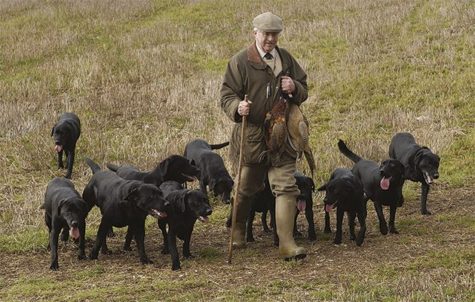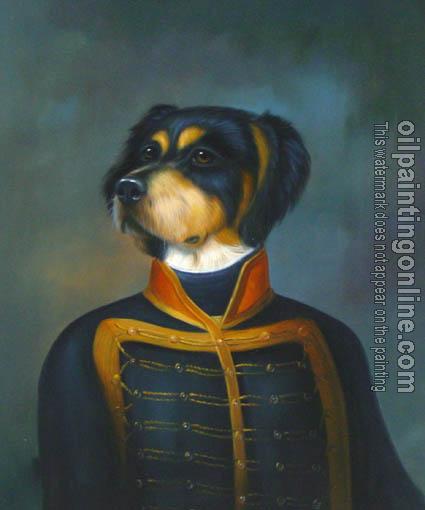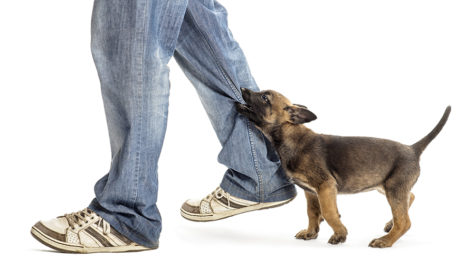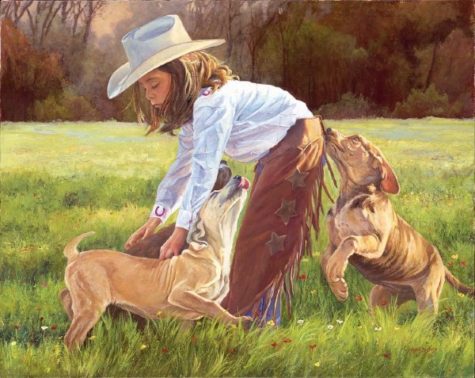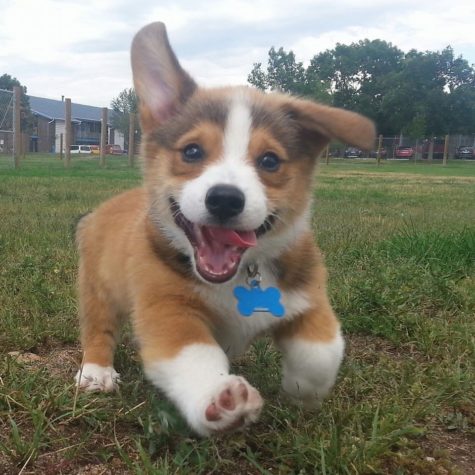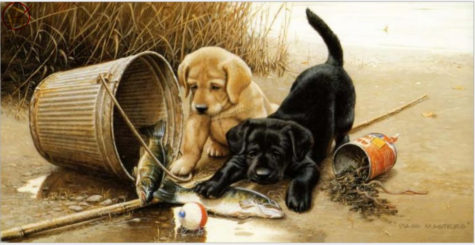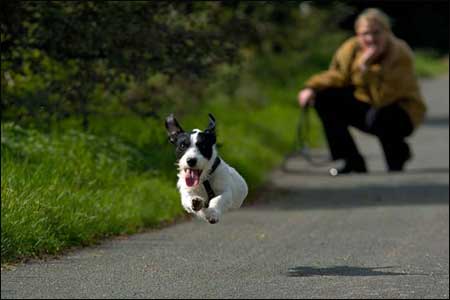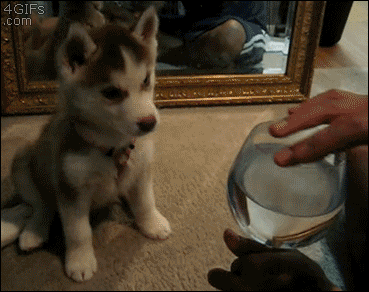Training Tips
Pack Leadership Do’s and Don’ts
Want to be the leader of your pack?
Follow these simple rules.
DO
- Eat before you feed your dog.
- Restrict access to your bedrooms and furniture.
- Take the shortest route to your destination and make your dog move out of the way.
- Proceed first through narrow passages.
- Run the opposite direction if your dog “takes off” on a walk.
- Take your dog’s “kills” (stolen articles or food) away.
- Call your dog to you to give affection.
- Ignore or discourage pawing, nudging, and whining.
- Ignore your dog first thing in the morning, when you get home, or when you come in.
- Restrict your dog’s movements with the “long down” exercise.
- Initiate games with your dog, make sure you win them and end up with possession of the toy.
- Reward your dog for completing an exercise well.
DON’T
- Feed your dog first.
- Let your dog sleep in or on your bed.
- Let your dog restrict your access to anything in the house or take up residence in a doorway.
- Let your dog bound out ahead of you.
- Chase your dog yelling “Come!”
- Allow your dog to keep or play with the “kill.”
- Go over to your dog to give affection.
- Give attention when your dog demands it.
- Make a large fuss over your dog whenever he demands that you do so.
- Give more than one command, or give up.
- Play games, especially tug of war, if you can’t win, or give the toy to your dog after the game is over.
- Give any command if you are not prepared to enforce it.
From: Cranbourne Dog Training School
The Pack Leader’s Bill of Rights
As pack leader, these are your rights. Giving these rights away to your dog sends the wrong message, and if you have an assertive dog, it can set the stage for behavior and obedience problems.
The pack leader’s rights are as follows:
- To eat first, gorge themselves, and own any pickings left over.
- To stand, sit, or lie down where ever they want – when ever they want.
- To have access to the “prime” spots in the household.
- To control entry to and from any room in the house.
- To proceed through all narrow openings first.
- To initiate the hunt, and dictate where to hunt.
- To make the kill at the end of the hunt.
- To demand attention from subordinate pack members.
- To ignore or actively discourage unwanted attention.
- To restrict the movements of lesser ranking pack members.
- To win all games.
From: CranbourneDog Training School
Bossy Puppies
How to handle your bossy, dominant, or aggressive puppy.
It is important to develop a good relationship with your puppy based on mutual trust and respect. The following techniques will help to foster this relationship. Different techniques should be used if your dog is older than 6 months.
FIRST:
Establish trust and a desire to please.
- Take long walks with your puppy (on leash).
- Spend 10 minutes every day brushing (grooming) your puppy.
- Attach your puppy’s leash to your waist and make your puppy go with you every where you go when you are home.
- If someone else is regularly feeding your puppy, assume that responsibility yourself.
- All the good things that happen to your puppy should come from you – not forever – but for now.
SECOND:
Establish respect and a willingness to obey using dominance techniques.
- Displace your puppy from a resting place.
- Restrain your puppy for a few minutes.
- Place hands and arms over your puppy’s neck and back, and exert pressure.
- Hold your puppy’s muzzle closed for a few minutes.
- Stare at your puppy until your puppy looks away.
- Pick up your puppy, either partially or completely.
- Push your puppy over on his side and hold him there.
- Roll your puppy over on his back.
Lots of praise when your puppy cooperates. Firm persistence if your puppy resists.
THIRD:
Assert your leadership in a firm and friendly way.
- Reward and/or praise submissive behavior.
- Hold training sessions several times a week.
- Always insist that your puppy obey all the rules.
- Make your puppy earn affection, food, and freedom.
- Firmly correct dominant and/or bossy behavior.
- Wild and unruly behavior is rewarded with a prolonged time-out.
FOURTH:
Learn to recognize and discourage dominant body language:
- Tall stiff stance
- Tail held high
- Flagging, or wagging tail in a taut stiff way.
- Ears up and forward.
- Growling, snarling, etc.
- Direct stare.
- Paws on or over person.
- Standing over someone or something.
FIFTH:
Pack leaders are aloof, they are calm, and they are self confident.
- Attention should be earned.
- Too much attention and coddling will give your puppy an inflated opinion of his place in the family.
- Everything you do with your puppy should radiate confidence and serenity.
- The pack leader is a fair dictator who enforces a well defined set of rules that members know, understand and are expected to live by.
Read and adhere to the Pack Leader’s Bill of Rights. Remember, you are the pack leader, not your puppy!
Written by: Shirley Gibson
Note:
You are welcome to share this post but ONLY IF you give credit and a link back to Teach Your Dog To Behave or shirleytwofeathers.com.
Temperament versus Personality
There are three basic temperaments:
- Submissive
- Responsive
- Aggressive
For a guide on training the basic temperament types, see this post: Temperaments and Training
There is a wide variety of personality types:
Slow * Calm * Sedate * Hyperactive * Goofy * Easily Distracted * Sensitive * Responsive * Focused * Independent * Insensitive * Unresponsive * Shy * Timid * Fearful * Combative * Domineering * Strong minded * Outgoing * Cheerful * Bossy * Lazy * Curious * Industrious
Different breeds of dogs are noted for certain qualities:
For example:
- Terriers – Combative, strong minded, aggressive
- Afghans – Independent, sensitive, uncooperative
- Border Collies – Intelligent, energetic, focused, responsive
Read about and become familiar with your own dog’s breed or combination of breeds. Mixed breed dogs tend to exhibit the qualities of the breed they most resemble.
How to assess your puppy’s temperament and personality:
- How your puppy interacts with family members in a familiar environment will give you a good idea of the personality type.
- How your puppy reacts to strangers in an unfamiliar environment will give a more accurate account of your puppy’s temperament.
What to look for:
- Dominance/aggression – ears and tail up, body stiff, hackles raised, slow deliberate movements, direct eye contact, barking and moving towards.
- Fear / possible fear induced aggression – ears back but tail up, or ears up and tail down, or ears and tail down, body stiff, hackles raised, mouth stiff, barking and backing up, crouching down, tail tucked under tummy, the tighter the tuck, the higher the level of fear.
- Submission – ears and tail down, wiggling, tail wagging relaxed and down, crouching, rolling over, paw up, licking.
- Friendliness / interest / moderate response – tail straight out, or possibly up but not high and stiff, ears perky, mouth open, body relaxed, tail wagging in a relaxed happy way, playfulness, caution without fearfulness.
Written by: Shirley Gibson
Note:
You are welcome to share this post but ONLY IF you give credit and a link back to Teach Your Dog To Behave or shirleytwofeathers.com.
Temperaments and Training
Your dog’s basic temperament is genetically encoded into his/her DNA. What follows is simple explanation of what type of training works best with each of the basic temperaments. For an explanation of temperament vs personality, and what to look for, see: Temperament vs Personality
SUBMISSIVE / fearful / combative
Can be a “fear biter,” must be handled carefully and calmly. Corrections must be firm but nonthreatening and impersonal. Lavish praise and gentle handling are very important. Can be very difficult to train.
SUBMISSIVE / sensitive / timid
Requires special handling, needs patience and understanding, but should not be coddled or spoiled. Too much coddling may turn this dog into a neurotic mess. Be firm, but use mild corrections. Lavish praise and a happy positive attitude goes a long way.
RESPONSIVE / sensitive / moderately submissive
Willing to please, eager to learn, quick to understand, responds well to mild corrections and generous praise. Care must be taken not to overly intimidate this type of dog. Can be quite bossy and naughty if spoiled.
RESPONSIVE / moderately aggressive
Willing to please, eager to learn, quick to understand, responds well to confident handling, firm corrections and generous praise. Easily spoiled. Can become a bratty “problem child” if not given rules and taught respect.
DOMINANT / strong minded / determined
Stubborn, does not like to submit to authority. Is sometimes willing to please, but not necessarily on your terms. Requires patient, persistent and firm handling, will take every opportunity to resist. Corrections should be vigorous and full of confidence. You must be assertive and demanding if you want this dog to respect and obey you. Generous praise is important, but it must be earned.
DOMINANT / aggressive
Resists learning, not eager to please. Requires special handling. You must be firm and strong minded with this dog. Avoid direct confrontations as a dog with this temperament will not be able to resist fighting back. Can be dangerous and difficult to train when fully matures.
Variations of the Basic Types
CALM / slow/ easy going
Willing to please, but not eager. Willing to learn, but not quick to respond. Praise, patience, and tolerance are needed. Go overboard with praise. Do not use harsh corrections with this dog.
EXCITABLE / high energy
This high energy type dog is easily distracted and excited about pretty much anything and everything. Requires firm but calm and patient handling, vigorous corrections, and quiet praise. Is often eager to learn and quick to understand, but may not be so willing to please.
INDEPENDENT / aloof
Self reliant and often mistrusting. Not a “people” dog. A good rapport is essential, corrections must be firm, but never harsh. Praise is very important. These dogs respond well to long walks, and a good run is an effective reward or form of praise. The more time you spend with this dog, the easier it will be to build the necessary rapport.
Written by: Shirley Janner
Note:
You are welcome to share this post but ONLY IF you give credit and a link back to Teach Your Dog To Behave or shirleytwofeathers.com.
Puppy Training – Reinforcements
What follows is an in depth explanation of the different forms of reinforcement, along with general guidelines about when and how to use them.
What is Reinforcement?
Reinforcement is information. It tells your puppy just what you like and don’t like. It works only on behavior that is already occurring. You cannot reinforce behavior that isn’t happening. Timing is critical. It must happen at the exact same time as the behavior you want to modify.
Positive Reinforcement
- Encourages specific behavior to be repeated.
- Something your puppy wants.
- Praise (“good puppy”). Tone of voice is very important.
- Petting, tummy rubs, etc.
- Attention, eye contact.
- Feels good.
- Use generously.
- Timing is critical – I cannot stress this enough.
- Positive reinforcement that occurs too soon teaches your puppy how to manipulate you.
- Positive reinforcement that occurs too late reinforces the wrong behavior.
- Positive reinforcements that involve food should be limited to one small mouthful. Use sparingly on specific behaviors only.
- Come when called.
- “Out.” Get your nose out of my food.
- Successful potty break outside.
- To revive interest in previously learned behaviors.
Negative Reinforcement
- Discourages specific behavior.
- Something your puppy wants to avoid.
- Verbal correction (“NO”), tone of voice important.
- Physical correction.
- Hard squeeze of muzzle or feet for jumping or biting.
- Sharp jerk with a leash, or hand on collar.
- Scruff shake.
- Quick spin through the air.
- Squirt bottle.
- Shake can or other sharp noise.
- Feels bad.
- Use sparingly.
- Timing is critical – I cannot stress this enough.
- Negative reinforcement that occurs too late is called “punishment” and does nothing to educate your puppy.
- Negative reinforcement that occurs too soon may actually prevent the behavior you are trying to encourage.
- Negative reinforcements should be only just strong enough to make an effective impression, but not so strong as to cause fear.
Jackpots
- A surprising reward 10 times bigger than what your puppy is used to (treats are acceptable).
- Can be used to mark a sudden breakthrough.
- And also as a morale booster.
- Will help your puppy maintain a positive attitude about you, and the training.
- Do not do this very often or it will use it’s effectiveness.
Conditioned Reinforcement
- Teaches your puppy to respond to the following:
- Verbal praise – an all purpose positive reinforcement.
- Verbal correction – an all purpose negative reinforcement.
- Other signals – reinforcement for specific behaviors.
- Sounds such as bells, clickers, whistles.
- Motions such as hand signals, or specific actions.
- Lights, or anything your puppy responds to visually.
- Establishes more exact communication.
- Tells your puppy exactly which part of a behavior you like the best.
- Reinforces behavior without interrupting it.
- Has more power than ordinary reinforcements because:
- It works on an unconscious level.
- Can be paired with several ordinary reinforcements such as:
- Food, water, and petting.
- Tummy rug, treats, focused attention.
- Loud noise, squirt bottle, leash correction.
- It says, “You’re right!” which is important information, and a valuable reinforcement by itself.
How to establish a conditioned reinforcement
- Verbal Praise
- Pick one phrase and use ONLY for this purpose.
- “Good Puppy” or “Very Good” or “Thank You”
- Something similar to the above.
- Always use a POSITIVE tone of voice.
- Say the phrase when giving food, water, treats, tummy rubs, ear scratches, etc.
- Do NOT continue to say the phrase after the positive reinforcement is finished.
- Pick one phrase and use ONLY for this purpose.
- Verbal Correction
- Pick one phrase and use ONLY for this purpose.
- “Bad” or “No” or “Shame on you.”
- Something similar to the above.
- Do not use in conjunction with your puppy’s name.
- Always use a STERN demanding tone of voice.
- Say the phrase when using negative reinforcements.
- Do NOT continue to say the phrase after the incident, or naughty behavior is finished and dealt with.
- Pick one phrase and use ONLY for this purpose.
- Signals, bells, clickers, whistles, lights, etc. for POSITIVE reinforcement.
- Make the signal and give a reward.
- Do this until the signal brings the puppy to you for another reward.
- When the connection between the signal and the reward is made, begin to use the signal to reinforce behavior while it is happening.
- Use the signal for ONE behavior at a time.
- Use your conditioned reinforcements sparingly.
- Try to pick words, phrases, and or sounds that your puppy will not ordinarily hear during the course of the day.
- Do not repeat the words or sound over and over again during the action unless you have a specific reason.
How to maintain what your puppy has learned.
- Random Reinforcement.
- Positive reinforcement should be constant and consistent during the LEARNING process only.
- As soon as your puppy has learned a specific behavior, cooperation is expected.
- Positive reinforcement is given only when the behavior is done quickly, or unusually well.
- Do not use random reinforcement to eliminate unwanted behavior.
- Avoid pampering and spoiling.
- If positive reinforcement is too easy for your puppy to achieve, the desire to try harder will NOT be reinforced, and you will get less and less instead of more and more.
- If negative reinforcements are easy to ignore, your puppy will continue to test established boundaries, and you will find yourself in a continual struggle for authority.
- Variable Schedule.
- Do NOT use when working to ELIMINATE behavior.
- Use when the behavior has been perfected.
- Gradually phase out positive reinforcements.
- Limit yourself to reinforcement, every 3rd, 5th, 7th, etc.
- Every now and then throw in a “jackpot.”
- Keep your puppy guessing.
- A long schedule is the most effective.
Exceptions to the variable schedule
- When you are working to eliminate an unwanted behavior.
- When solving a puzzle, or taking a test.
- When it is necessary to make a choice between two or more items, or actions.
- Whenever independent thinking is required, some sort of feedback is necessary, and can be in the form of conditioned reinforcements.
Written by: Shirley Janner
Note:
You are welcome to share this post but ONLY IF you give credit and a link back to Teach Your Dog To Behave or shirleytwofeathers.com.
Puppy Training – Guidelines
Know and understand your puppy.
- Your puppy’s temperament will determine what rewards and which corrections will be most effective.
- Take into consideration how your puppy reacts to his senses.
- Don’t forget that your puppy is a DOG, and that certain behaviors are part of his DNA and to be expected.
- Dogs and puppies are motivated by pleasure, pain, fear, and also by their assessment of their place in the family or pack.
- Dogs and puppies have a strong need for leadership. If you do not take the role of leader, your puppy will.
Teach one thing at a time.
- Too many different things at once can be confusing.
- Divide complicated tasks into simple steps.
Take it one small step at a time.
- Make steady improvement easy for your puppy.
- Do not expect too much too soon.
Don’t rush the training.
- You have to walk before you can run.
- Patience and repetition are important words to remember.
Temporarily ease up on everything else when introducing something new.
- The key word here is TEMPORARY.
- Do correct mistakes, but gently and with patience.
- Expect mistakes whenever something new is introduced, or when working with your puppy in a new place.
Plan ahead.
- Know in advance the desired result.
- If your puppy suddenly catches on to what it is you want, this will give you a good opportunity to make quick progress.
If what you are doing isn’t working…
- If what you are doing isn’t working, and you’ve put in the time, the repetition, and the patience – rethink your strategy.
- Trust your intuition.
- Be open to new ideas.
Timing is very important.
- Everything that happens to a puppy happens right now.
- Praise and correction must be handed out during or immediately following the behavior or yhour puppy will not get the message.
When working with your puppy, stay focused.
- Don’t stop in the middle of a session to talk on the phone, smoke a cigarette, or etc.
- Remember, training is a form of communication.
- Removal of attention can be a negative reinforcement.
Positive and negative reinforcements, how to use them:
- The reward for good behavior must outweigh the pleasure gained from the bad behavior.
- The correction must override but not overwhelm the will of the puppy to continue with the bad behavior.
- Use lots of positive reinforcement.
- Be sparing but effective with the negative reinforcements.
If your puppy suddenly “forgets”…
- If your puppy suddenly “forgets” what he has learned, go back to the basics.
- Sometimes a quick refresher is what is needed.
- A relapse midway into training is common and usually means you are about to make a major breakthrough – so don’t get discouraged and quit.
Quit while you are ahead.
- Make progress in each training session
- End each session on a high note.
- Too much pressure or too many repetitions can ruin a training session. Three times in a row is usually suficient.
- If necessary, end the training session on something easy.
A successful outcome depends on these factors:
- Patience and persistence
- Consistency and repetition.
- Whether or not you took the time to follow through.
Written by: Shirley Janner
Note:
You are welcome to share this post but ONLY IF you give credit and a link back to Teach Your Dog To Behave or shirleytwofeathers.com.
Training Do’s and Don’ts
All dogs (unless physically handicapped) see and hear and have feelings, so your first concern should be from your pup’s point of view. One very good way to consider him is to form one especially important habit right now. If you smoke, never do it while training or playing with your Buddy. A hot ash, accidentally dropped in his eye could cause irreparable damage.
Your body can be a towering mass for your pup to fear, or, as we hope, it can be his security and something to love. In training, try to visualize everything from his point of view. Therefore, instead of bending over so that you still tower over him, it’s much better to squat down and let him see you at the same level he is.
Be careful, too, about how you use your eyes. As crazy as it may seem to you, they can be very upsetting to your pup. Never stare at your Buddy; look over his head or to one side of him. Don’t forget that your intentions are transmitted to your pup in many ways, sometimes even in ways that we cannot fathom or explain to our own satisfaction. The bond that develops between the two of you is a great fulfillment and should not be dealt with lightly.
A list of ‘Do’s’ for training:
- Teach only what you understand.
- Follow any correction with praise and work.
- Work with your pup as a team.
- Wear quiet, comfortable shoes when training.
- Wear clothing that does not interfere with your pup.
- Stop your training before losing your temper.
- Be consistent with your training, at home or in class.
A list of ‘Don’ts’ for training:
- Correct by slapping with a lead.
- Correct if you are not positive your pup fully understands.
- Be a show-off with your training.
- Over train.
You know your dog-work WITH him. Don’t confuse him with sudden drastic changes. Avoid resentment as well. Practice. Practice. Practice. Take nothing for granted.
-excerpts from
The Pearsall Guide to Successful Dog Training
by Margaret E. Pearsall
Getting started with Dog Obedience Training
This was my standard handout for dog obedience classes.
You will need:
- Time – 1 hour a day
- Patience
- A sense of humor
- A strong desire to succeed
Training Collar:
- Sometimes called a “chain” or “choke” collar
- To insure a proper fit, the collar should slide easily, but not loosely, over your dog’s head. A training collar that is too loose will not work properly.
- Choose one with wide links – training collars made with thin narrow chains tend to cut into the dog’s neck.
- Don’t skimp on quality when choosing a training collar, pick a brand that is guaranteed against rust and breakage.
Regular Collar:
- If you have a shy, timid, or very small dog, we may decide to use a leather collar for training.
- Should fit tightly enough that only 2 fingers will fit between the collar and your dog’s neck. This is a safety precaution. If the collar is too loose and your dog balks or backs up, a loose collar will slide over your dog’s head and come completely off.
Other Collars:
- Depending on the situation, the size, sensitivity, and temperament of your dog, we may recommend the use of a ‘pinch’ or ‘prong’ collar for training.
- Small dogs and puppies that are shy, timid, very young, or very submissive may be started with a leather collar. It should fit tightly
enough that the collar cannot accidentally slip off your dog’s head. - Nylon slip collars will not be practical for training as they have a tendency to get caught in long hair, will heat up with repeated use, and often do not release properly
Leash:
- Retractable leashes and chain leashes are not practical for training.
- It is very important that your leash be six feet long. A four foot long leash will not be long enough to teach ‘stay’ and ‘come.’
- Leather is better, but nylon or cotton will do just fine.
- When choosing a leash, find something that feels comfortable in your hands. Something light and thin will be fine for small dogs, but if you have a large out of control dog, you will want a leash that will not cut into your hands.
- A good clasp is very important if you have a big strong dog, or a dog that pulls hard on the leash.
Training Area:
- When teaching your dog something new, choose a place to work with your dog where there is a minimum of distractions.
- When practicing commands that your dog already knows, choose a place with many temptations and distractions so that you can reinforce the training.
- A large area is nice, but all you really need is enough room to walk with your dog at your side.
- As soon as your dog knows and understands a command, begin to use it as part of your dog’s daily life. Do not, however, overwhelm your dog with obedience, especially in the beginning.
Treats:
- For puppy classes, treats are a great asset, but for the basic obedience training, I do not recommend the use treats as part of the
training. - This is because too often the dog learns right away to only perform if there is a treat involved.
- When dogs are stressed or nervous, when they are excited about new sounds and smells, when there is the distraction of other dogs and new people, or if your dog is timid or shy, they are not the least bit interested in even the most savory of treats.
- Also, the goal is for the dog to obey you, and listen to you because they love and respect you, not because there’s something in it for them.
Written by: Shirley Gibson
Note:
You are welcome to share this or use it in your own classes, but ONLY IF you give credit and a link back to Teach Your Dog To Behave or shirleytwofeathers.com.
